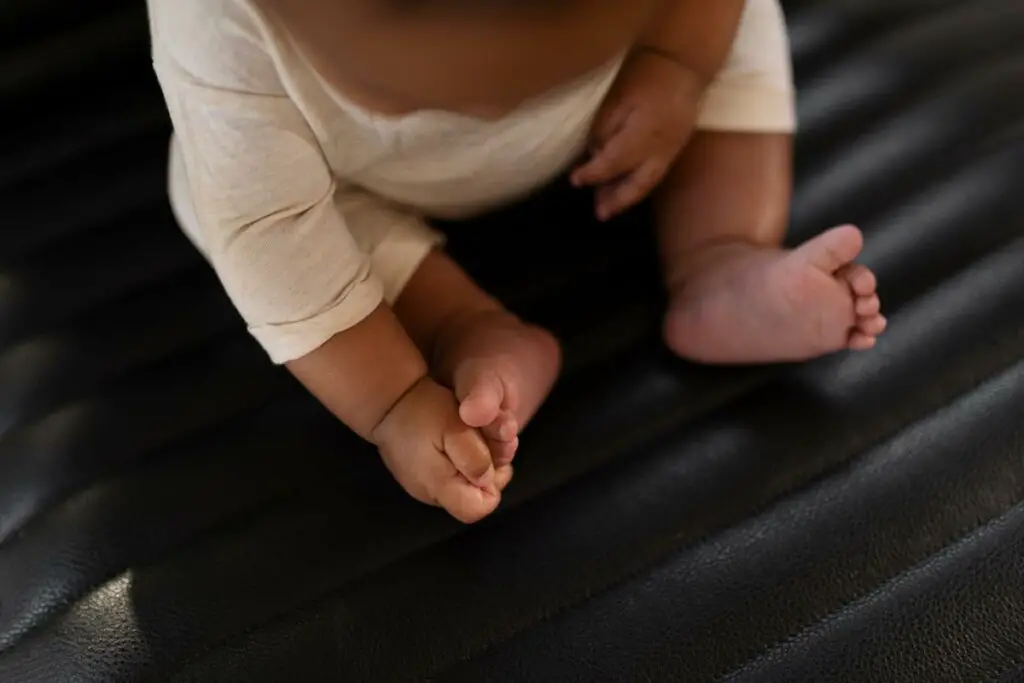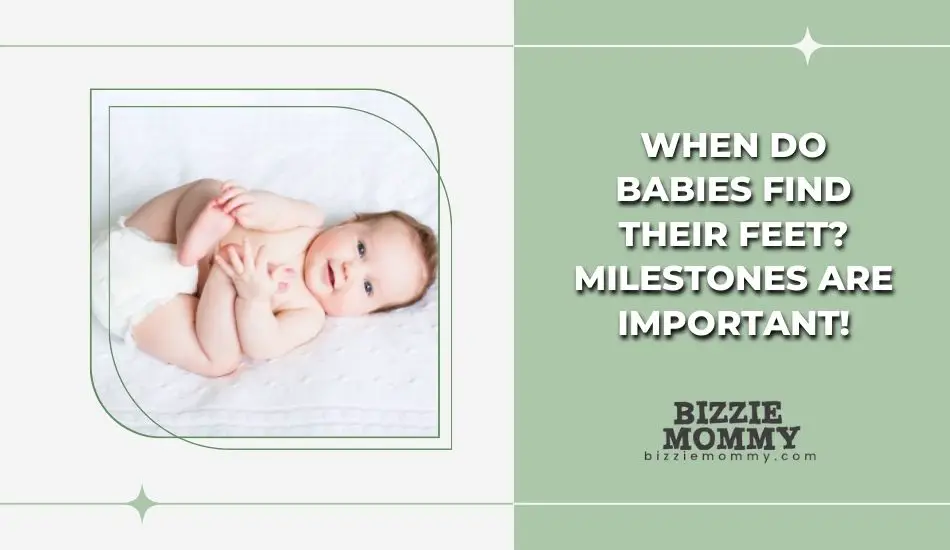Any developmental milestone is a very big deal for any parent, and a common one is when babies get more control over their own bodies. The most common form of this is seen when babies learn about their feet, but one must know that it is not as important as it sounds.
Babies move around to get to know their own body better. When babies learn about their feet, a very common reaction many of them have is to grab them, bring them as close to their face as they can, and suck their toes, but this is not universal. While some babies might be very interested in their toes and feet, some might not care even a little bit about their newfound body parts. Every baby has his/her own likes, dislikes, interests, and developmental stages. Let your baby learn things at his/her own pace. They will grow up before you know it, so spend this time as happily as you can.
When Do Babies Start Playing With Their Feet?
Babies usually start playing with their feet at about 4-6 months old. This is a part of their sensorimotor exploration, where they get a better awareness of their own body and hence, start to take part in simple, playful activities. It is also around this time that babies learn how to bring their feet up to their hands and mouth, and this is usually fun for them too.
They grab their feet, pull their tiny toes, and even try to put their feet in their mouth because they find it very amusing. This is due to their increased motor coordination and body awareness. Playing with his/her feet is not simply fun for the baby, but it also helps to develop motor skills and muscle coordination. When they reach for their feet, they strengthen their core muscles and legs. This also improves their hand-eye coordination.
Every baby develops at his/her own pace, so the exact age at which they start playing with their feet may vary. Should you worry about your baby’s motor skills development, consulting with your pediatrician is always a wise course of action.
Do All Babies Put Feet In Mouths?
No, not all babies put their feet in their mouths. It is quite common for babies to grab their feet and pull them in every direction they possibly can; it is still not something universal. Every baby has their own preferences and milestones.
Babies who put their feet in their mouths usually do it out of pure curiosity and wonder. The mouth is a sensory organ for babies, which is why we see those little being putting every possible thing in their mouths. It is just a means of exploration for them; so many babies do the same with their feet. But this does not mean every baby will want to do this. Some babies prefer using their mouths for exploration; some prefer grasping objects, while some are just happy observing an object closely.
It’s important to remember that developmental milestones will vary from baby to baby. As long as your baby is showing age-appropriate motor skills and showing curiosity and exploration in other ways, there is generally no cause for concern if they don’t put their feet in their mouths. Nevertheless, if you hold particular worries regarding your baby’s growth, it’s consistently wise to seek advice from your pediatrician.
How Can I Help My Baby Find Their Feet?
You can assist your baby in discovering and exploring their feet through various methods, including:
- Giving your baby ample time to play and investigate on a floor surface that is both safe and clean. They move around on the floor as much as they can, and this gives them the space and freedom to discover things, including their own body parts.
- When your baby is playing or even when he/she is simply doing nothing, remove their socks and shoes. This allows them to have direct contact with their feet and improves their sensory experience.
- Tummy time plays a crucial role in your baby’s overall growth. It aids in fortifying their neck, shoulder, and core muscles, as well as enhancing their motor abilities. During tummy time, place interesting objects and toys near your baby’s feet to encourage them to reach for them. This can help them try and grab their tiny feet.
- Choose toys or objects with bright colors and different textures that will look attractive to your baby. Put these toys near your baby’s feet during playtime, and try to get your baby to grab their toys.
How Do You Know When the Baby Has Discovered Its Feet?
You can look for certain signs and behaviors to determine if your baby has discovered their feet. Here are some common signs:
They are more focused:
When babies discover their feet, they often start paying more attention to their lower bodies. If you notice that your baby is looking down more often, especially during application time, it could be because he/she has discovered his/her feet.
They will be reaching and grabbing:
As babies develop their hand-eye coordination, they will start to reach for their feet with their hands. They may try to grab their feet or toes, partially because they’re finally aware of this body part they did not know of previously and partially because they are interested in them.
They will start exploring:
Babies who have discovered their feet will start exploration. They will touch, feel, and explore their feet with their hands, as well as bring their feet closer to their body to explore them.
They will start bringing feet to mouth:
A common behavior when babies discover their feet is to try to bring their feet to their mouth. They could start to try to suck on their toes or chew on their feet as part of their exploration and sensory experience.
They could be delighted:
When babies find their feet, they often show signs of joy, amusement, or surprise. You may notice smiles, giggles, or excited reactions when they successfully reach their feet or engage with them in some way.
Is Baby Grabbing Feet A Milestone?
No, grabbing or playing with their feet is not considered a specific milestone in the usual developmental timeline for infants. Milestones are a baby’s first major accomplishments or skills that most babies achieve within a certain age range, indicating their progress in various areas of development.
However, the act of the baby’s hands grabbing their feet and playing with them can be seen as part of the broader motor and sensory development of those little angels. It is a sign that babies are becoming more aware of their bodies, improving their coordination, and exploring their environment.
While grabbing their feet is not a specific milestone, it is a natural part of their exploration and sensory development. Each baby develops at their own pace, so the timing of when they start engaging with their feet will be different. It’s important to focus on the overall progress and range of skills your baby is learning rather than specific isolated actions.
What Other Milestones Should a 3-Month-Old Reach?

When a baby is three months old, there are many more baby milestones other than grabbing their feet. It is a very exciting time, as a baby starts to learn many motor, social, and emotional skills, such as:
Motor milestones:
- By three months, most babies are able to hold their heads up steadily when they are in a straight, upright position. During tummy time, they can lift their heads for short periods and may even attempt to push up on their arms as their upper body gets stronger.
- At this stage, infants become more active and start moving their limbs with purpose. They may kick their legs, wave their arms, and have a much better grasp reflex. This increased movement shows the development of muscle strength and coordination.
- Three-month-old babies begin to develop hand-eye coordination. They can track moving objects with their eyes and can start reaching out to grasp toys or objects within their reach. While their pincer grasp strength may still be weak, they are developing their ability to reach and explore objects with their hands.
Sensory and cognitive milestones
- Three-month-old babies show great improvements in their visual tracking abilities. They can follow objects or people with their eyes as they move in front of them. They can even turn their heads to track a moving toy or follow the movements of people around them.
- Babies at this age start to have longer attention spans. They can work with objects or faces for longer periods, showing interest in their surroundings and maintaining attention on specific objects or people they find interesting.
- Three-month-olds start to explore objects with a sense of purpose. They could reach out to touch and grasp toys or other objects within their reach. They could also bring objects to their mouths as a way of exploring them through their sense of touch and taste.
- Babies become more responsive to familiar sounds and voices. They may turn their heads towards familiar voices or sounds that catch their attention or the ones they recognize, like the sounds of their parents or siblings.
- Three-month-old babies continue to develop their communication skills. Although they won’t be able to talk, and you might not understand what they are trying to say, they will show an increase in their range of babbling and will try to say more things.
- While they may seem too young, babies at three months begin to develop a basic understanding of object permanence. They can get surprised or shocked if an object is hidden out of their sight.
Social and emotional baby milestones:
- Three-month-old babies become more socially responsive. They actively seek social interaction and engage with others through eye contact, smiles, and cooing. They enjoy being spoken to, sung to, and played with. They also show a lot more responses.
- By three months, babies begin to recognize and respond differently to familiar faces, especially those they see the most, i.e., their caregivers. They could show signs of recognition by smiling or becoming more animated when they see familiar faces.
- Babies at this stage start to communicate their needs and emotions more actively. They start making cooing sounds and gurgling and will try to get your attention toward what they want or need.
- Three-month-old babies show a wider range of emotions and can express them through their facial expressions, sounds, and body language. They will be able to better show their joy, excitement, and satisfaction, and may also show signs of discomfort or frustration.
Bottom Line
At three months, babies learn about their feet and try to play with them as much as possible, but this is not necessarily a very big developmental milestone. There are many other babies who would prefer not to bring their feet to their faces or will not even pay much attention to their feet. All of this is completely normal. If you feel concerned at all about your baby’s development, it is better to contact your family nurse or doctor to get advice, but remember that every baby develops in his/her own time. No need to rush through the process because, this time, it won’t come back.

